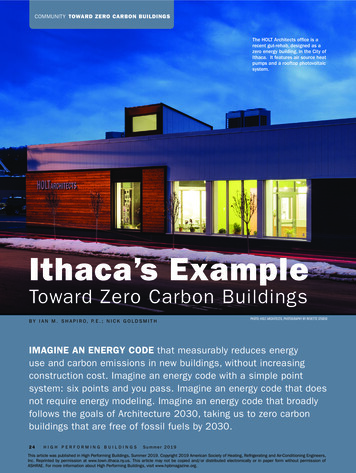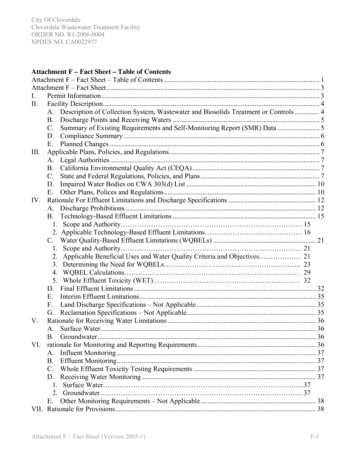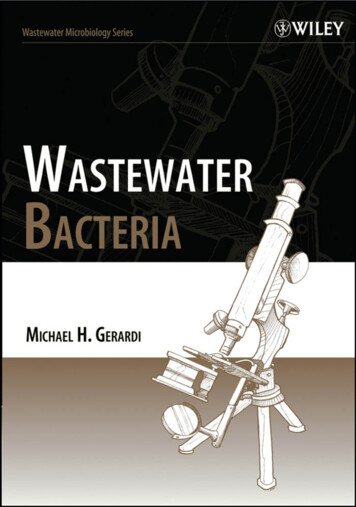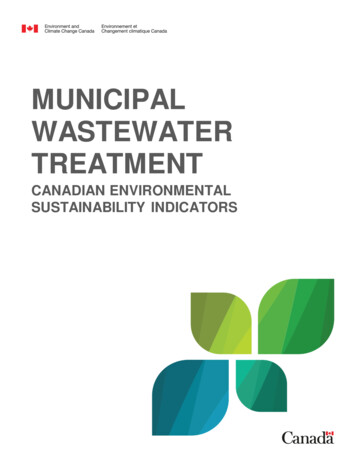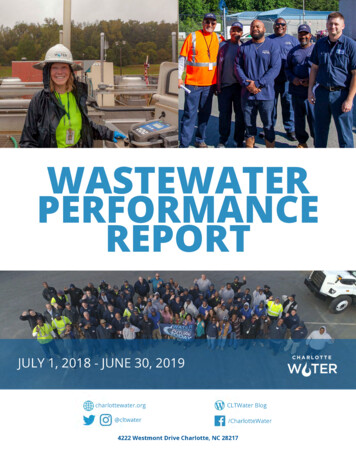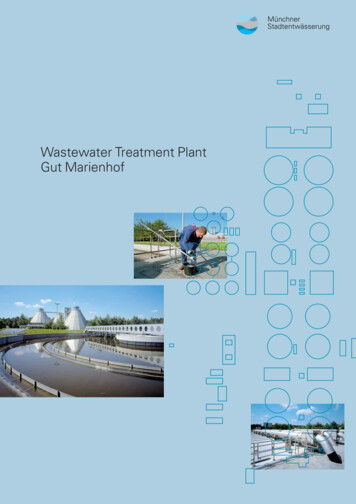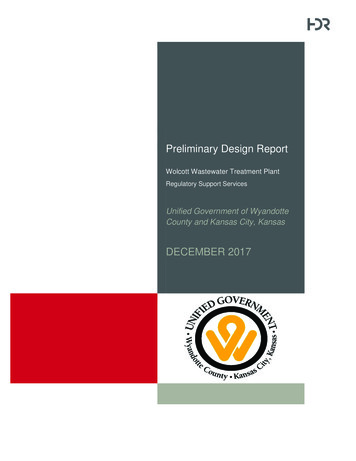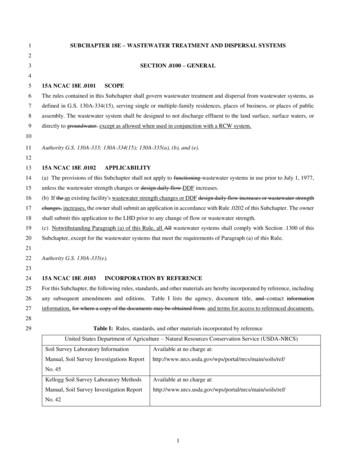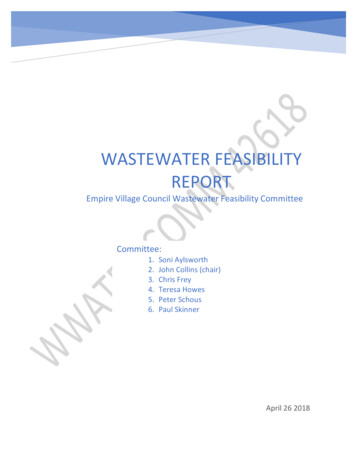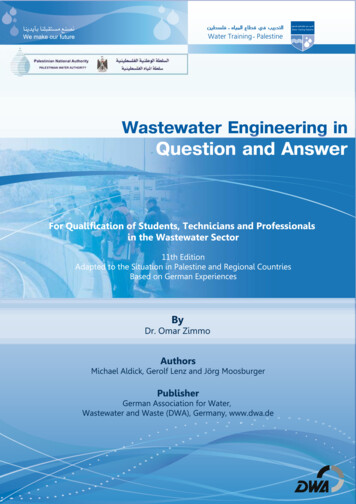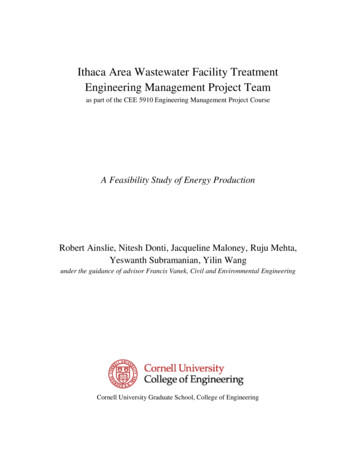
Transcription
Ithaca Area Wastewater Facility TreatmentEngineering Management Project Teamas part of the CEE 5910 Engineering Management Project CourseA Feasibility Study of Energy ProductionRobert Ainslie, Nitesh Donti, Jacqueline Maloney, Ruju Mehta,Yeswanth Subramanian, Yilin Wangunder the guidance of advisor Francis Vanek, Civil and Environmental EngineeringCornell University Graduate School, College of Engineering
Table of ContentsAdvisor Introduction . 4Executive Summary . 5Introduction . 6Mission Statement. 6Project Motivation. 6Project Goals . 6Team Members. 7Assignment of Team Members to Topic Areas of Project . 9List of Project Assumptions . 10List of Project Boundaries and Project Scope . 11Inside Scope: . 11Outside Scope: . 11Literature Review . 12Waste-to-Energy Systems . 12Small Scale Waste-to-Energy Applications . 12Possible Fuel from Chicken Feathers . 13Solar Energy and Regulations in Ithaca . 13What is Solar Power?. 13Types of Solar panels and their Merits/Demerits: . 14Drawbacks of Investing in Solar Technology . 15Recently Established Snyder Road Solar Farm in Tompkins County . 17Alternative Energy Sources . 18Hybrid system – Solar PV and Wind Turbine. 18Low-head Turbines . 19Transportation Fuel Technologies. 20Natural Gas and Bio-SNG . 20Hydrogen Fuel Cells . 21Plugging Into Electric Vehicles . 21Fleet Managers Save Millions with CNG . 22Microgrids . 22District Energy . 25Grants . 26Energy Usage in a WWTF . 26Information and Initial Data . 28Ithaca Wastewater Treatment plant. 28Major Source of Waste . 29Waste Processing . 30CHP Initiative of IAWWTF . 312
District Energy . 32Key parameters considered for model . 33Optimization and Modeling . 34Current Status . 36Scenario Analysis . 38Scenario 1: . 38Scenario 2: . 39Scenario 3: . 40Scenario 4 . 41Scenario Comparisons . 42Final Recommendations . 43Future Projects . 43Appendix A: Calculations . 46Current Status:. 46Scenario 1: . 48Scenario 2A: . 49Scenario 2B: . 51Scenario 3: . 53Net revenue comparison of electricity and biodiesel produced by the same amount ofgrease . 55How much biogas required to produce energy . 55Solar Capacity . 56Appendix B: References . 573
Advisor IntroductionThis report summarizes the findings of a one-semester project analyzing the proposedexpansion of energy conversion of biological waste materials (food scraps, food industry byproducts, sewage, septage, and the like) at the Ithaca Area Wastewater Treatment Facility, orIAWWTF. The research in the project was carried out by a team of Master of Engineeringstudents from the Engineering Management, Environmental Engineering, and TransportationEngineering programs.As advisor, it has been my responsibility to create the foundation for the launch of the project,mostly during the summer of 2014, by working with partners who also have an interest in it. DanRamer, Jose Lozano, and Jim Goodreau at the IAWWTF plant have been interested for some timein the subject of increasing the self-reliance of the plant for electricity, and provided much of theinitial information. Kushan Dave, student of City and Regional Planning, and his advisor GeorgeFrantz, also provided an input into the project with their planning concept for the development ofthe area around the plant, as well as some of the initial figures for the dimensions of thedevelopment. Finally, the Energy group of IAWWTF (a committee of interested individuals fromoutside the plant staff), including members Wade Wykstra, Tom Hanna, Anna Kelles, and JohnBozack, as well as Bruce Abbott and John Graves with whom we previously worked on theEmerson Plant repurposing project, provided input into the project. This project also benefittedfrom information gathered from several previous M.Eng. projects advised by me and focused onlocal issues, including TCAT fleet operations, repurposing of the AES Cayuga power plant,Ithaca energy-efficient neighborhoods, Black Oak wind farm, and the aforementioned Emersonplant. Interested readers may wish to download project reports similar to this one atwww.lightlink.com/francis/.One of the challenges with the project format is that the students must carry out a project thatthey did not design within the space of a single semester. Not only must they create from theframework that I provide a coherent scope of work, but they must also self-organize the team andexecute the project during the course of the semester. No previous background in wastewatertreatment systems is required to join the team, so students joining have varying degrees offamiliarity with the technologies and systems. They must therefore dedicate a substantial fractionof the time in the project researching the state of the technology, especially near the beginning.As advisor, I can report that the team successfully overcame these challenges and met theirresearch objectives, and I am pleased share the results of their work with a wider audience.In closing, I wish to thank all of the above individuals for their input into the project. Whilethis support is gratefully acknowledged, the findings and opinions in this report do not representofficial positions of the IAWWTF or Cornell University, and responsibility for any and all errorsrests with myself as advisor and with the team.Respectfully submitted,Francis M Vanek, PhDSenior Lecturer and Research AssociateDecember 18, 20144
Executive SummaryThis report presents the opportunity for the Ithaca Area Wastewater Treatment Facility(IAWWTF) to maximize its revenue by utilizing the potential of existing Combined Heat andPower (CHP) turbines and exploring other energy sources and their possible implementations.The report also analyzes four different scenarios to maximize revenues for the plant by increasingthe capacity of CHP turbines and adding other alternative sources of energy, such as biodiesel,solar photovoltaic and hydro-turbines. This feasibility study is intended for the use of theIAWWTF and professionals interested in producing electricity and heat in a moreenvironmentally friendly way. We hope that our study will help the IAWWTF and the Ithacacommunities to reduce their CO2 footprints.CHP is a reliable, cost effective option for the IAWWTF to meet their current energy demand of334,200 kWh per month using the two existing bio-digesters. The IAWWTF currently has thecapacity to produce approximately 120,000 to 150,000 cubic feet of biogas per day, which is usedas a fuel for the four CHP turbines, each with 65 kilowatts (kW) of capacity, to produce200,520 kWh of electricity per month. The thermal energy produced by the CHP system is thenused to heat the bio-digesters, which need to be maintained at a temperature of 98 F for 28 daysto produce methane.Every one million gallons of wastewater flow per day can produce enough biogas in an anaerobicdigester to support 26 kW of electric capacity and 2.4 million Btu per day (MMBtu/day) ofthermal energy in a CHP system1.The IAWWTF has been exploring various means of producing electricity, and as part of theinitiative, they have already implemented a 7.5 kW solar system inside their facility. This array iscapable of producing 9,210 kWh of electricity per year.Additional electricity produced by the CHP turbines can be used to power the plant and make theplant self-reliant. By doing this, the plant avoids a cost of 10.5 cents per kWh, which is currentlythe cost paid to utility companies.Maximizing the intake of waste can help produce additional kW of electricity, which can be soldto the new proposed development at 14 cents per kWh.The IAWWTF currently receives an average of four percent grease as part of its trucked waste.The cost of producing bio-diesel is considered to be 3.11 per gallon, but it can be sold to thenearby TCAT facility at a price of 3.50 per gallon. Alternatively, if 80-gallon biodiesel1Opportunities for Combined Heat and Power at Wastewater Treatment Facilities: MarketAnalysis and Lessons from the Field (n.d.): n. pag.Environmental Protection Agency. CombinedHeat and Power Partnership, Oct. 2011. Web. 7 Oct. 2014. http://www.epa.gov/chp/documents/wwtf opportunities.pdf .5
processors can be used, the price per gallon for production could be reduced to 2.18 per gallon,using available capital and operating cost figures, making biodiesel more economically attractive.IntroductionMission StatementThe Engineering Management Project Team works to determine how much energy,whether biogas or alternative, the Ithaca Area Wastewater Treatment Facility (IAWWTF)can produce and at what price, and explore possible uses for this energy. We haveestimated the energy consumption of the proposed Inlet Energy Improvement District andanalyzed the needs of the community compared to the output capabilities of theIAWWTF. We have also taken into consideration the implementation cost and revenuegained from each of the scenarios considered.Project MotivationAs graduate students in engineering we gave back to the Ithaca community that haseducated us over the past four years. We gained the experience of working within aninterdisciplinary team to face the challenges of a large engineering project. We wereinterested in learning about wastewater treatment and creating an optimal system thatallows the IAWWTF to not only have increased revenues but also decrease greenhouseemissions. By focusing on an economic analysis of Kushan Dave’s original proposal, weaimed to prove or disprove its feasibility.Sustainable energy is an up and coming field with a great deal of applications. As a resultof the negative effects of pollution on climate change, finding sustainable solutions hasbecome increasingly important. Waste management systems that can convert harmful ordiscarded materials into useful forms of energy are just one way that we can make apositive impact on society. We want to help create a reliable energy source in Ithaca byutilizing a variety of waste streams that would have otherwise ended up in a landfill. Notonly does this plan decrease the amount of waste sent to landfills, within which wastecannot decompose quickly, but it can produce usable energy for the community,decreasing dependency on non-renewable energy sources.Project GoalsFirstly, our team analyzes the output potential of the IAWWTF in terms of biogas capacity,hydro-turbine feasibility and significant solar energy production increases. We also analyze theneeds proposed by the Ithaca Energy Initiative Development using Ecovillage data as a baselinefor calculations. Using both of these analyses, our team proposes useful possibilities, such asselling biogas to TCAT buses, selling electricity back to the grid or reselling repurposed enrichedwaste.6
Team MembersNitesh DontiUndergraduate Education: Cornell University, B.S. Computer ScienceGraduate Education: Cornell University, M.Eng. Engineering ManagementMy background is in computer science and business. I have extensive internshipexperience in software engineering within a variety of industries. In addition, I havesignificant business development and entrepreneurship experience within the educationspace.Jacqueline MaloneyUndergraduate Education: Cornell University, B.S. Civil EngineeringGraduate Education: Cornell University, M.Eng. Engineering ManagementMy background is in structural engineering and project management. Two internships inconstruction management and extensive Concrete Canoe project team experience havegiven me many relevant management and interpersonal skills.7
Ruju MehtaUndergraduate Education: Cornell University, B.S. Environmental EngineeringGraduate Education: Cornell University, M.Eng. Engineering ManagementMy background is in civil and environmental engineering. Through different internshipsin the energy utility and engineering management/consulting sectors, I have gainedexperience in CAD drafting, water systems, and enhancing client interactions.Yilin WangUndergraduate Education: B.S. Civil Engineering, University of WashingtonGraduate Education: Cornell University, M.Eng. Transportation EngineeringMy background is civil engineering, with a concentration in transportation. Internshipsand student organization experience have strengthened my data analysis, systemoptimization, and communication skills.8
Rob AinslieUndergraduate Education: Cornell University, B.S. Environmental EngineeringGraduate Education: Cornell University, M.Eng. Environmental EngineeringMy background is in environmental engineering and business management. Through mycoursework and work experience I have developed a unique combination of technical andanalytical skills that allows me to effectively and creatively solve problems.Yeswanth SubramanianUndergraduate Education: Anna University, Chennai, India. B.E. Electronics andCommunicationHumber College, Toronto. Postgraduate Diploma in Wireless Telecommunication.Graduate Education: Cornell University, M.Eng. Engineering ManagementMy background is in telecommunications and program management. I am aprofessionally qualified engineer and program manager with seven years of experience indelivering complex telecommunication projects within the oil, gas and utility sectors andfor major telecommunication operators.Assignment of Team Members to Topic Areas of ProjectWe have divided the project into three distinct parts, each of which is detailed belowalong with according team member assignments. Since each of the teams is dependentupon the others, there was significantly more overlap among groups than is outlined here.Continuous communication and feedback were expected to be shared among all threegroups throughout the duration of the project, especially after all options had beenconsidered and analyses had been conducted. Final recommendations have been basedupon input from all team members.9
1. Optimization and Modeling: Nitesh and JacquelineUsing the data and information provided by the IAWWTF and Prof. Vanekand gathered from the research team, this group is responsible for creating theanalysis tool. This includes synthesizing all of the information anddeveloping a tool that is easy to manipulate.2. Environmental Analysis: Ruju and RobThis group provides a feasibility study on the sources that can be used in theplant. This includes an optimization on energy creation and profits. Anyoptions that poorly use the resources can be eliminated along with solutionsthat do not yield adequate benefit or profit. A simple economic analysis willbe considered here to determine the most profitable options, assuming there isdemand in the market for sellable energy.3. Research and Recommendations: Yilin and YeswanthThis final group will make suggestions about the types of energy that shouldbe used and for what purposes. Taking into account cost, environmentalimpact and feasibility, this team explores the possibilities encapsulated in eachscenario and analyzes energy and other byproduct production. A harder lookat the economic analysis will be considered here to determine whether it is infact feasible to sell energy products produced to external users.List of Project AssumptionsIn order to make progress, we made numerous assumptions about the project. To begin,we assumed that there are no social and political barriers to our efforts in this energyinitiative. We assume that we can get all of the necessary permits and approvals from thegovernment and will not face any opposition from the Ithaca community.Also, we assume that the smell and noise of the plant do not deter residentialconstruction, and that any smell or noise produced from waste processing or energyproduction processes is within a tolerable range. However, it would be the responsibilityof any residential or commercial developer to make sure that this requirement is met,since failure to meet it could jeopardize the viability of the whole project.We assume that the entire redevelopment project from Kushan Dave’s plan is completed,or if not, we assume that the resulting electricity demand is proportional to the fractioncompleted. We assume that the grid will include the demand from the proposedredevelopment project so that a microgrid can be established. We also assume that theredevelopment project will be finished (as opposed to partial completion), so that we canestablish an approximate demand.10
Capital investments assume an investment lifetime of 20 years, and a discount rate of 7%.The discount rate is a standard U.S. government figure.Finally we assume that whatever energy we create at the facility can be easily and readilytransmitted to its final location. We assume that transportation infrastructure changes (fortransporting steam, hot water, electricity, etc.) are feasible and at a negligible cost.List of Project Boundaries and Project ScopeInside Scope:Our project scope encapsulates the maximization of energy production to increaseddemand, feasibility of meeting increased demand of microgrid conditions, and proposingareas that the IAWWTF can improve to increase to increase its profit. Renewable energysources that we consider are solar, biogas, micro-turbines and hydro-turbines.Outside Scope:Any renewable energy production method not listed in the scope above is considered tobe outside the scope. A detailed operational exploration of the technologies (biogas,solar, hydro-turbine, etc.) suggested from an engineering perspective will not beperformed. In conducting a feasibility study, understanding and assessing the big pictureimplementation, rather than operation, is more beneficial for the facility itself. We willnot explore implementation of energy or fuel distribution systems, microgrid details, orplans to store energy. We are not responsible for identifying additional sources of wasteto meet increased waste demand of certain scenarios or potential buyers of the enricheddry biocakes. Carbon dioxide emissions are also outside the scope of this project.11
Literature ReviewWaste-to-Energy SystemsAll objects, no matter the form, contain energy. Waste-to-energy systems reconstruct theenergy in trash into usable forms while consolidating trash in the process. However,waste-to-energy processes have the potential to release toxins into the ambientenvironment. For example, incineration is a common form of converting waste-to-energythrough heat production but it also produces airborne pollutants and unfavorable odors.Environmental Protection Agency (EPA) regulations make it nearly impossible to burntrash in the open.A number of technological advancements have been made in order to produce energyfrom our trash. A Tactical Garbage to Energy Refinery (TGER) has been successfullyimplemented in military applications to power a 60-kilowatt generator. It converts wasteinto fuel pellets, which are then gasified and turned into synthetic gas resemblingpropane. Organic waste (liquids and food) is processed into a hydrous ethanol. Thesynthetic gas and hydrous ethanol are then combined to produce fuel. TGER systems donot process glass, metals or hazardous waste.Pyrolytic gasification is another form of energy production from waste. In this process,waste is cooked in batches under indirect heat and low oxygen. The final product of thisprocess is an inert ash that can be used in building materials. This ash comprises 20% ofthe previous volume of waste. The process produces 80% of the energy it uses. In otherwords, the process does not produce excess energy; rather, it uses the energy it producesso that it can degrade waste safely with little energy used.Many of these systems have been converted into modular units for military use. Thesystems usually are comprised of solid waste management, water purification and powergeneration systems.2Small Scale Waste-to-Energy ApplicationsHeat is a product of most waste to energy plants, but it is often underutilized because ofgreat distance between the plant and the consumer. This heat can be sold at steam or aspart of a combined heat and power system. According to Small Scale Community PlantsWay Forward for Waste Gasification, facilities that gain full utilization of heat potentialcan increase their efficiency up to 85%. Smaller plants also minimize traffic and can be2Wingfield, Rebecca C. "Waste-to-Energy Systems." ProQuest. Superintendent of Documents,United States Army, Jan.-Feb. 2009. Web. 8 Oct. 2014. ntid 10267 .12
combined with other facilities (such as recycling and wastewater treatment) to decreaseenergy costs and carbon emissions for the local community. They also reduce theamount of heat energy lost in the process. 3The article Review of Small Scale Waste to Energy Conversion Systems takes a very closelook at several international implementations of small scale Waste to Energy systems. 4Possible Fuel from Chicken FeathersThis article opens up the doors to possible fuel sources that are currently underutilized.Chicken feathers, currently used as an additive in low-grade animal foods, can beconverted into usable energy. Feather meal contains 12% fat, which can be easilyconverted into biofuel. The 11 billion pounds of chicken waste can be converted into 153million gallons of biodiesel each year. While that may not even come close to coveringthe diesel demand in the US (According to Vanek et al (2014, p.479) in the year 2000passenger cars consumed 73 billion gallons of motor fuel and light trucks includingpickups, vans, and SUVs consumed another 53 billion gallons), it does make scientistsand environmentalists think about what alternate sources of fuel exist.Extracting fat from the feathers not only provides an alternate source of energy, butincreases the quality of the animal feed and provides a better nitrogen source infertilizers. Additionally, there are also applications for feathers to be used in fuel storagesystems. 5Solar Energy and Regulations in IthacaWhat is Solar Power?Solar power is the conversion of sunlight into electricity and the mechanism in which theenergy is obtained is classified into two types: Concentrated solar power (focus a large area of sunlight into narrow beam usingmirrors) Photovoltaic (converts light into electricity)3"Small Scale Community Plants Way Forward for Waste Gasification." Waste ManagementWorld. N.p., 25 June 2012. Web. 04 Oct. 2014. astegasification.html .4Stein, Wes, and Lasse Tobiasen. "Review of Small Scale Waste to Energy ConversionSystems." IEA Bioenergy Agreement - Task 36 (2004): n. pag. IEA Bioenergy. 2004. Web. 5 Oct.2014. 12003/Publications/Review of Small Scale Waste Conversion Systems.pdf .5"Fuel from Chicken Feathers." Alternative Energy News. Biodiesel, Biofuels, Waste Energy, 22Mar. 2010. Web. 04 Oct. 2014. chickenfeathers/#.VCg55MmbALs.gmail .13
Solar or Photovoltaic panels produce DC current, which fluctuates with the sunlight’sintensity. For commercial applications, DC is converted into AC current using inverters.Types of Solar panels and their Merits/Demerits:1. Mono CrystallineThese type of panels are made from silicon ingots which are cut into cylindricalshapes to be embedded into panelsAdvantages Highest efficiency as they are made out of high-grade silicon 15 to 20% efficiency. Sun power has produced X series with 21.5%efficiency Requires less space, and produces four times yield as thin films Usually manufacturers provide 25 years warranty and have longestlifetime Tend to perform better even in low-light conditionsDisadvantages Expensive If the solar panel is partially covered with shade, dirt or snow, the entirecircuit can break down Tend to be more efficient in warm weather2. Poly CrystallineMelting raw silicon and pouring it into a square mold, which is cooled and cutinto perfectly square wafers, manufacture these types of panels.Advantages
Executive Summary This report presents the opportunity for the Ithaca Area Wastewater Treatment Facility (IAWWTF) to maximize its revenue by utilizing the potential of existing Combined Heat and . Graduate Education: Cornell University, M.Eng. Transportation Engineering My background is civil engineering, with a concentration in .
